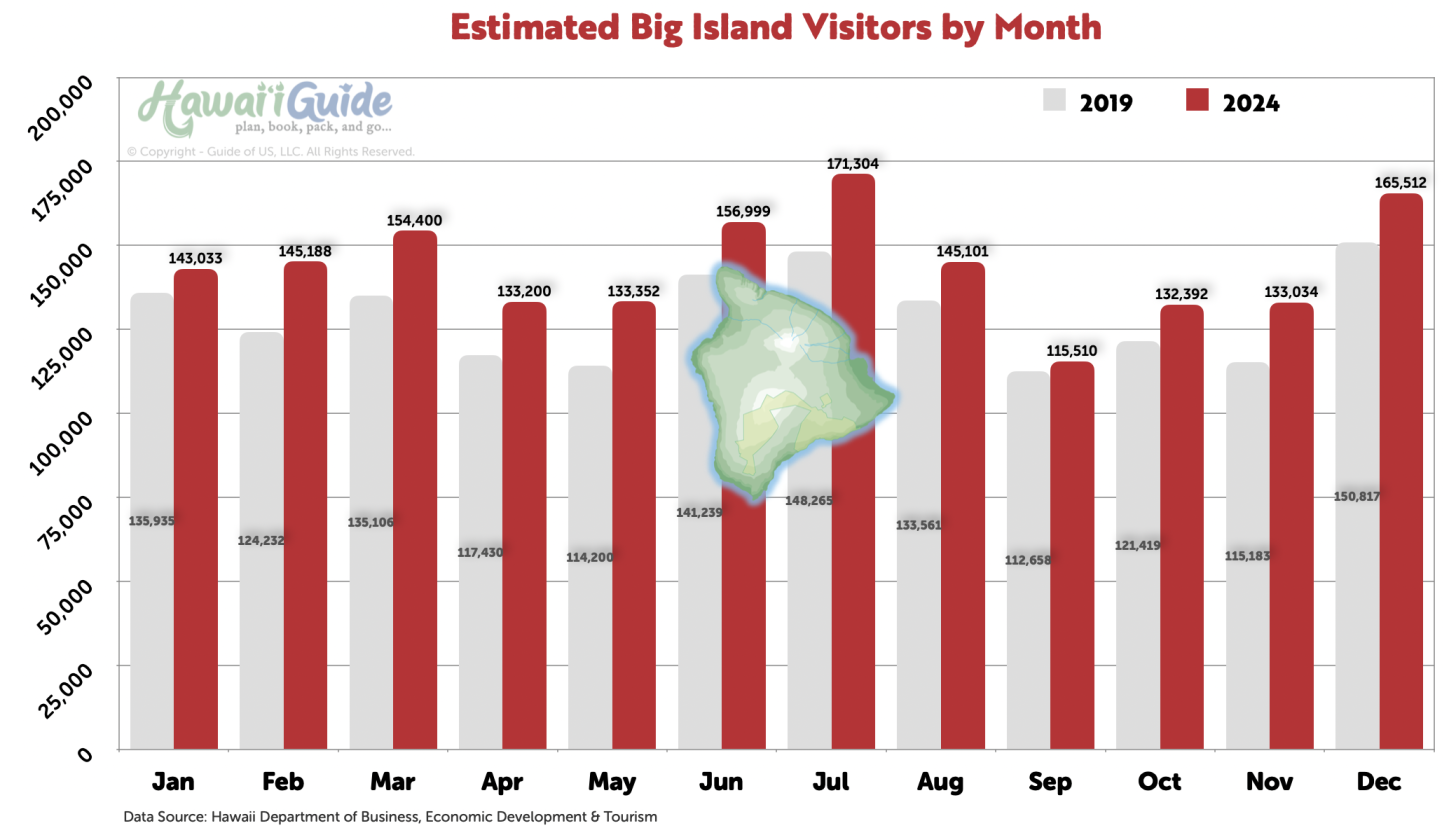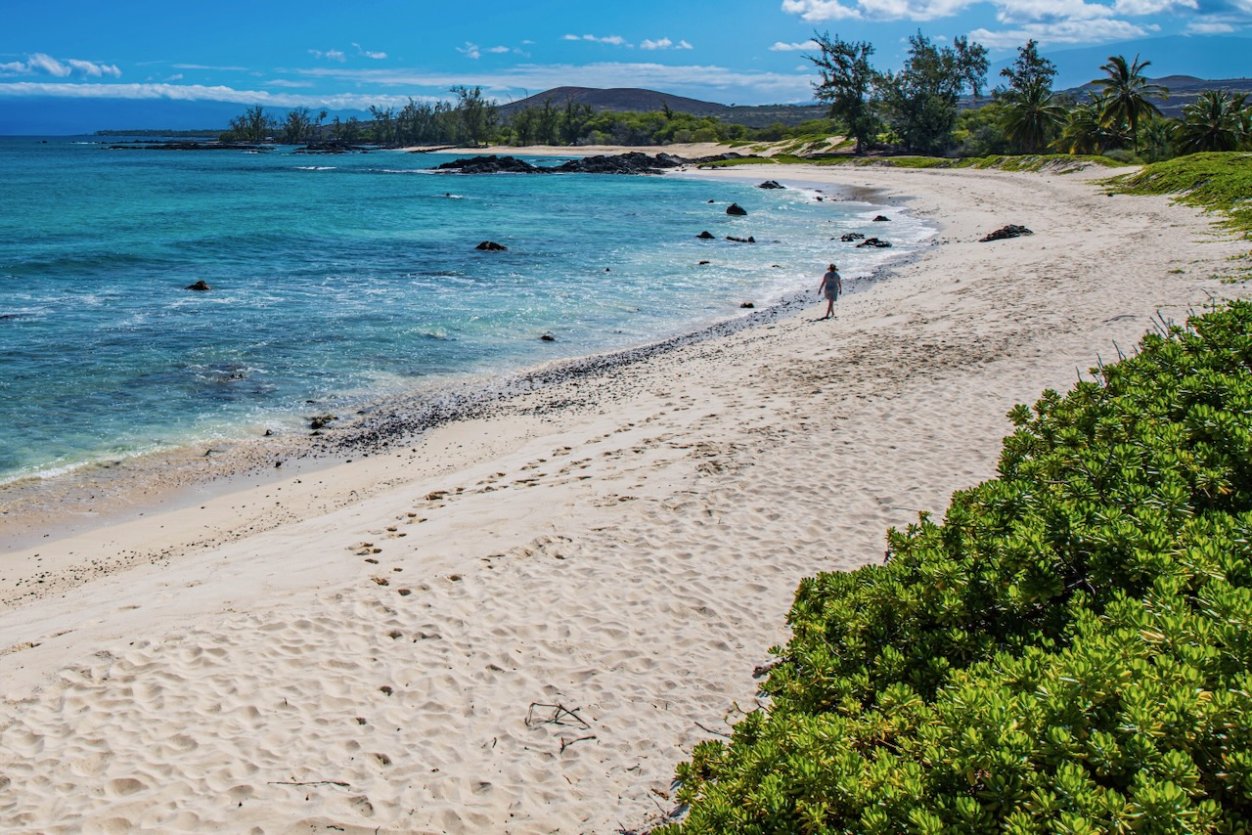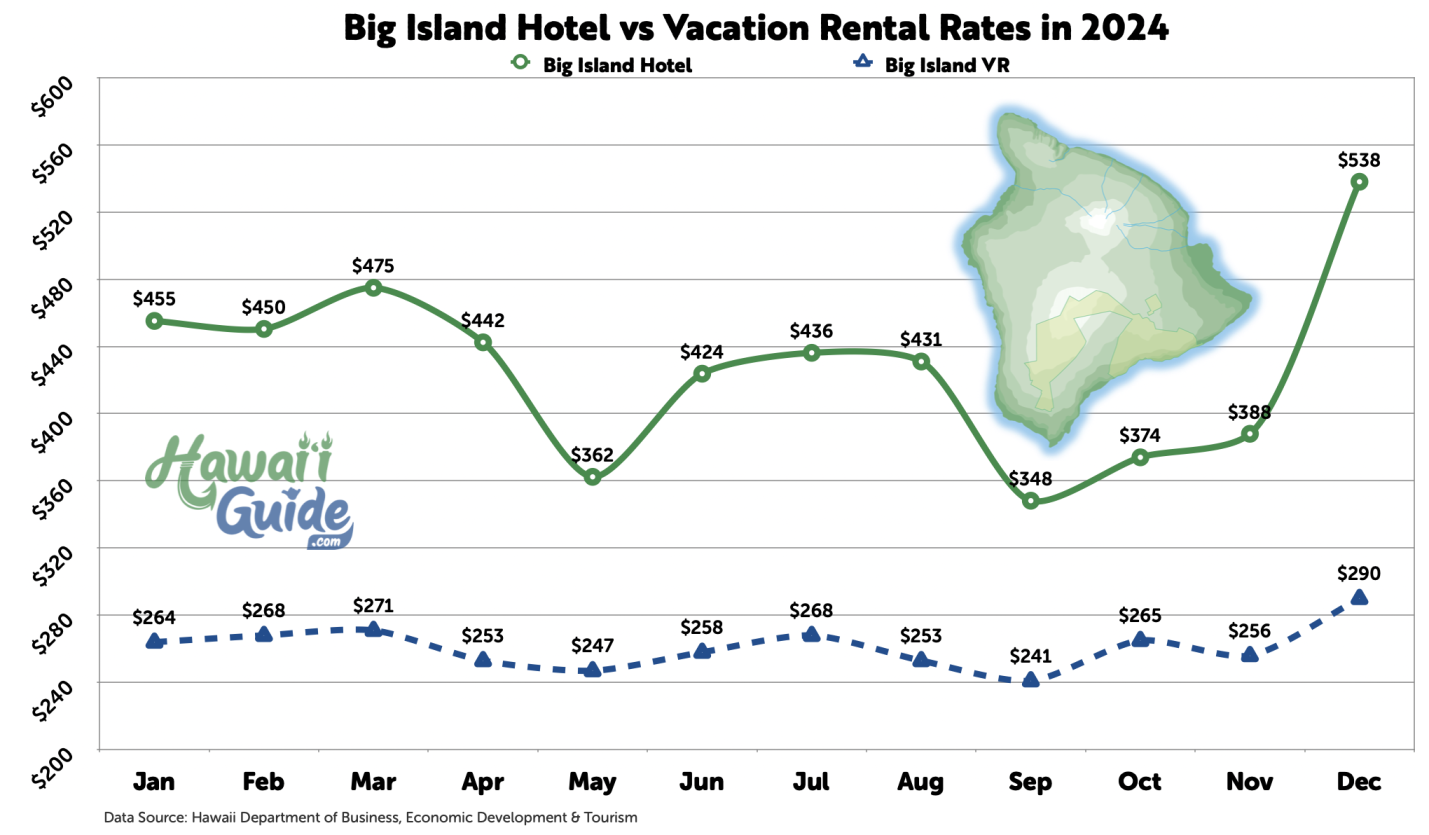03-10-2025
When to VisitBest Time to Visit the Big Island
When to Visit the Big Island of Hawai'i
Top Times of Year to Travel to the Big Island
This article may contain affiliate links. We earn a small commission at no extra cost to you. Mahalo!
Best Time to Visit Big Island
Big Island of Hawai'i Tips for When to Visit
Knowing when to visit the Big Island of Hawai'i is essential when planning your Big Island trip or vacation. Honestly, there's not a wrong time to visit the island - it has an incredibly wide diversity and geography that suits almost any type of traveler- from outdoor adventurer to poolside fixture.
But, that said, some months are still better when considering things like weather and your budget. The best times to visit the Big Island of Hawai'i, taking into consideration the weather, how crowded, or not, the island is, and demand for accommodations are the month(s) of April, May, August, September, and October. Some call these Hawai'i Island's 'off-season periods' or the 'shoulder months.'
Below we'll cover visitor arrivals, the Big Island's weather and climate, accommodations, rates, and what to expect on a visit during each season on the Big Island.

Kilauea Iki Trail inside Hawai'i Volcanoes National Park
Big Island Visitor Arrivals

Typical Big Island Visitor Arrivals (2024 vs 2023 vs 2019)

Typical Big Island Visitor Arrivals (2024 & 2019)

Typical Big Island Visitor Arrivals (2023 & 2022)
What to Expect on the Big Island in 2025
Price increases will continue to impact flight costs, the costs associated with rental vehicles, and potentially Big Island accommodation rates. Already we've seen 20-30% increases in fares over pre-pandemic (2019) rates on the Big Island.
Visiting Hawai'i within the next few years, between 2025 - 2026, means you'll avoid the increased crowds projected to return by 2027-2028 and beyond. So if you're visiting the Big Island of Hawai'i soon, you've selected a great time!
We'll keep you posted... this article will be updated accordingly as things change.

Makalawena Beach in the morning
Big Island any time of the year
If you're planning to visit during the winter months, you will have the opportunity to see humpback whales that migrate every year from Alaska to mate, calve, and birth their young.
No matter when you visit, we recommend booking one of the amazing guided tours of the Big Island offered by our friends at The Volcano Van. They offer some of the most exciting Big Island Tours you'll find.
Weather & Climate
For the most part, the Big Island is warm and tropical year-round. Average temperatures near the major resort areas (coastline) range from 75-85°F (23°C-29°C) in winter and summer, respectively.
At the higher elevations like Volcano and Waimea, temperatures are often much cooler, especially during the night. Hilo can also have lower temperatures depending on how far mauka (inland) you travel. And, of course, the summit of Mauna Kea and flanks of Mauna Loa or Hualalai can be quite chilly, if not downright frigid; so plan accordingly depending on where you plan to visit during your trip.
For more detailed information about the weather conditions you can expect during your visit, check out our Big Island of Hawai'i Weather page.
Hurricane Season
Hurricane and tropical storms are historically rare events on the Big Island and within Hawai'i in general, but it’s still important to be prepared for storms if you visit during Hawai'i hurricane season - June through November. The last few years have seen increased activity around the islands, including the Big Island, so it’s essential to monitor weather conditions when planning and taking your trip.

Awini Trail beyond Pololu Valley
Accommodations & Rates
The busiest time on the island is around the Christmas holidays, New Year, and Independence Day in the U.S.
Many families also visit the island during the summer months while their children are out of school. These busy months all mean increased demand and higher prices island-wide.
Two other events that generate an influx of visitors are the Merrie Monarch Festival and the Ironman competition. The Merrie Monarch Festival is held annually starting on Easter Sunday on the Hilo side of the island. The Ironman Triathlon event is held on the Kona side of the Big Island of Hawai'i, typically in October.
If you’re not sure which Big Island region(s) to visit, you may want to have a look at our Where to Stay on the Big Island of Hawai'i article to narrow down your options.
Below, we'll cover our Big Island of Hawai'i Seasonal Expectations on visiting during each season of the year.

Big Island Accommodation Rate Averages

Green Sand Beach in Kau (South)
Big Island Seasonal Expectations
Events Updated for 2025
We've included the dates and months that most Big Island events are typically held below, but please be aware that currently, things are subject to change.
Visiting Big Island in January, February, or March
This is a good time of year to visit if you have your heart set on seeing the majestic Humpback Whales. The weather is also noticeably cooler at this time of year, though there may also be a chance for increased precipitation during these winter months.
Hotel rates are often reasonable this time of year as well. Additionally, even though surfing isn't as popular on the Big Island as some of the smaller islands, this is still prime season to catch some waves.
Big Island Winter Events:
- Mitsubishi Electric Championship (January) - Held at Hualalai, this tournament offers fans the chance to see the best players on PGA TOUR Champions with a strong field of qualifiers.
Be sure to also regularly check our Big Island current event pages for:
Visiting Big Island in April, May, or June
This is one of the best times to visit the Big Island of Hawai'i, in our opinion. Rates and demand are usually down at this time of year, though both increase heading into June as more crowds arrive from the mainland for the summer break.
Big Island Spring Events:
- Merrie Monarch Festival (April) - A week-long festival featuring an internationally acclaimed hula competition, a Hawaiian arts fair, hula shows, and a grand parade through Hilo town.
- Lei Day (May) - Celebrated on the first of May, a festival takes place in Hilo offering lei making, a lei contest, hula performances, and more.
- Ka'u Coffee Festival (April-August) - This event features a pageant, recipe contests, food, crafts, farm tours, and yes, plenty of coffee.
- Big Island Chocolate Festival (late April) - The Festival includes seminars, demonstrations, a student chef competition, a professionally judged cacao bean taste-off, and much more.
- King Kamehameha Day (June) - A celebration honoring Hawai'i's first king with events on both sides of the island.
Be sure to also regularly check our Big Island current event pages for:
Visiting Big Island in July, August, or September
In our opinion, the later months in this period are another great time to visit the Big Island of Hawai'i. While July and August can both be a bit busier as family vacations wind down from the summer break, by late August and early September, the crowds have usually cleared out and rates have decreased.
This time of the year can be warmer on the island, though the temperature increase isn't drastic.
Big Island Summer Events:
- Hawai'i Volcanoes National Park Cultural Festival (June) - This free event is held in HVNP with performers, food, drink, and music.
Be sure to also regularly check our Big Island current event pages for:
Visiting Big Island in October, November, or December
October can also be an excellent month to visit Hawai'i. The weather has cooled and demand and rates have dropped too, with fewer visitors on the island. By mid-to-late November, the wetter weather will be more noticeable, as November and December are some of the wettest months on the island.
Additionally, as always, crowds and rates skyrocket closer to the end of December for the holidays.
Big Island Fall Events:
- Ironman Triathlon (October) - Over 2,000 athletes will embark on a 140.6-mile journey that presents the ultimate test of body, mind, and spirit to earn the title of IRONMAN.
- Kona Coffee Cultural Festival (November) - During this 10-Day Festival, there are tastings, hands-on cultural events, and stories to help tell the rich history of Kona’s coffee.
- Kailua-Kona Christmas Parade (December) - Held on the Kona side of the island, typically, the second week of December.
Be sure to also regularly check our Big Island current event pages for:
Local Big Island Customs and Visitor Etiquette
Understanding and adhering to local customs and etiquette is a crucial part of immersing oneself in the Hawaiian culture, which is deeply rooted in respect, tradition, and the spirit of 'ohana (family). When visiting the Big Island or any part of Hawai'i, it's important to show respect for the land (‘āina) and local residents.
- Greetings: It's customary to greet others with a friendly "Aloha" which means hello, goodbye, and love.
- Shoes Off Indoors: It’s a common practice to remove one’s shoes |before entering someone’s home.
- Respect the 'Aina: Show respect to the land by not littering, staying on marked trails, and not taking anything from natural sites.
- Don’t Rush: The pace of life is slower in Hawai'i; embrace the relaxed pace and don’t rush.
- Respect Sacred Sites: Many areas in Hawai'i are considered sacred; obey posted signs and keep a respectful distance.
- Driving Etiquette: Drive with aloha; let others merge, and wave a thank-you (or practice your best 'shaka' sign) if someone lets you in.
By adhering to these simple yet significant customs and practices, visitors can contribute to preserving the local culture and enjoy a more authentic and welcoming experience during their stay on the Big Island of Hawai'i.

Big Island is beautiful all year long.

Kilauea Eruption inside Hawai'i Volcanoes National Park
Our Suggestions for Where To Stay
*Big Island of Hawai'i monthly Visitor Statistics are provided by the Department of Business, Economic Development & Tourism.

Updated on: 03-10-2025
Published by: John C. Derrick
Founder & certified Hawai'i travel expert with 20+ years of experience in Hawai'i tourism.
You may also be interested in...
2025 Big Island
Visitor Guides
Visiting the Big Island of Hawai'i soon?
View Free Guide
~ Detailed maps, insider tips, hotel recommendations, tour & activity suggestions, local dining, and more! ~
Affiliate Disclosure: We may earn commissions from some travel partners (like Amazon or Expedia) which helps us maintain this site. These links are at no extra cost to you and don't impact our honest & unbiased recommendations. Remove all the ads →
Article Published/Updated: 03-10-2025




